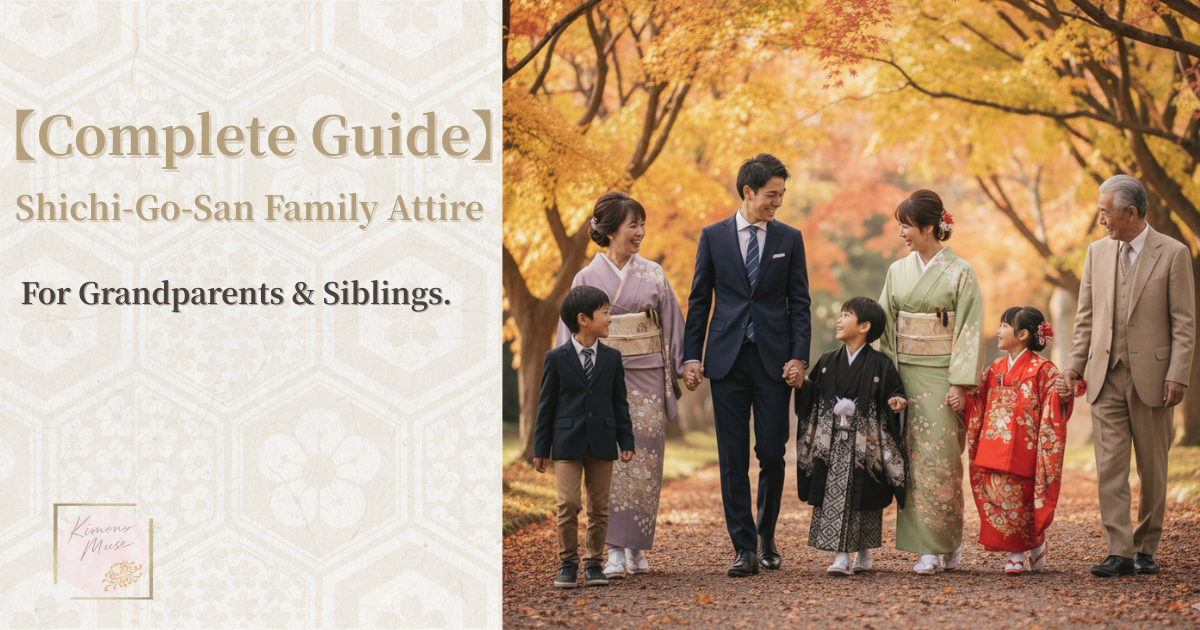Shichi-Go-San is a precious milestone event to celebrate your child’s healthy growth.
While the children are the main focus, the attire of grandparents and siblings also plays a key role in maintaining family harmony and creating beautiful, well-balanced photos.
“Is it inappropriate for a grandmother to wear kimono?”
“What kind of suit is safe and fail-proof for a grandfather?”
“What outfits look best on siblings in the commemorative photos?”
In this article, we’ll clearly explain dress etiquette for grandparents and siblings—highlighting both what to avoid and recommended styles.
We’ll also cover everything you might wonder about, from the typical amount of congratulatory gifts to the family’s roles on the day itself—making this a truly Complete Guide.
- Shichi-Go-San Dress Etiquette: Basic Guidelines for Grandparents and Siblings
- Complete Guide to Grandparents’ Attire: NG Examples and Suggested Styles
- Shichi-Go-San Siblings’ Outfits: NG Examples and Recommended Styles by Age
- Q&A for Grandparents and Siblings: Money, Roles, and Other Etiquette
- Conclusion: Etiquette Is Consideration — What Truly Matters Is the Family’s Smiles
Shichi-Go-San Dress Etiquette: Basic Guidelines for Grandparents and Siblings
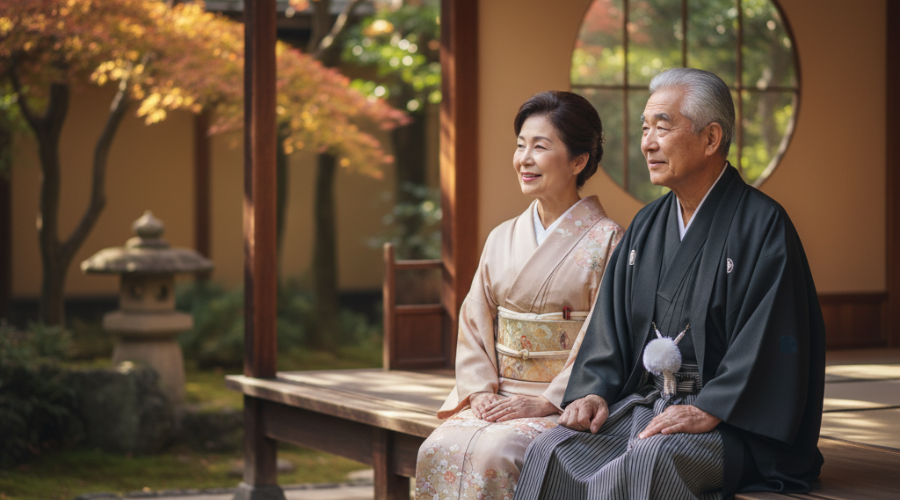
In this section, we’ll introduce the essential etiquette for grandparents and siblings, focusing on key points for maintaining family harmony as well as age-appropriate kimono styling tips for siblings.
Family Harmony: The Most Important Rule is “Matching the Formality”
For both grandparents and siblings, the golden rule of attire when accompanying children to Shichi-Go-San is not to outshine the main stars (the children) and to match the level of formality with the parents’ outfits.
| Relation | Rules to Follow | Examples to Avoid |
|---|---|---|
| Grandparents | Match the formality level of the parents’ outfits. If the parents wear Western-style clothing, opt for Western attire; if they wear kimono, choose kimono as well. This creates harmony and unity. | If the parents dress casually, but the grandparents wear highly formal attire (such as a morning coat or montsuki kimono with haori and hakama), the level of formality becomes unbalanced. |
| Siblings | Choose outfits that highlight the main stars—the children. Go for subdued colors and patterns, making sure the clothing doesn’t overshadow them. | Wearing clothes more extravagant than the children’s outfits, or extremely casual clothing such as denim or sweatshirts. |
Photo-Friendly Tip: Create “Family Unity” by Coordinating Colors
When the color tones of everyone’s outfits are aligned, group photos gain a professional sense of unity.
Discuss in advance as a family, and choose basic colors such as navy, gray, or beige as the base—this approach is always a safe choice.
Siblings in Kimono: Traditional Age-Based Customs and Rules
When siblings wear kimono, there are traditional customs that vary depending on age.
Since the type of kimono that can be worn differs by age, it’s important to confirm these details in advance.
| Siblings | Age | Kimono Customs |
|---|---|---|
| Boys | 5 and older | A formal outfit is a kimono with haori (jacket) and hakama (pleated trousers), the same style as adults. |
| Up to 4 | Traditionally, boys cannot wear hakama until after the “Hakamagi no Gi” (ceremony of putting on hakama). However, wearing hakama at age three is permitted if it coincides with Shichi-Go-San. The style is usually a kimono with haori but without hakama. | |
| Girls | 7 and older | The standard style is a kimono worn with an obi (belt/sash). |
| Up to 6 | Since it is difficult for younger children to wear an obi properly, the common style is a kimono worn with a hifu (padded sleeveless jacket). |
Complete Guide to Grandparents’ Attire: NG Examples and Suggested Styles
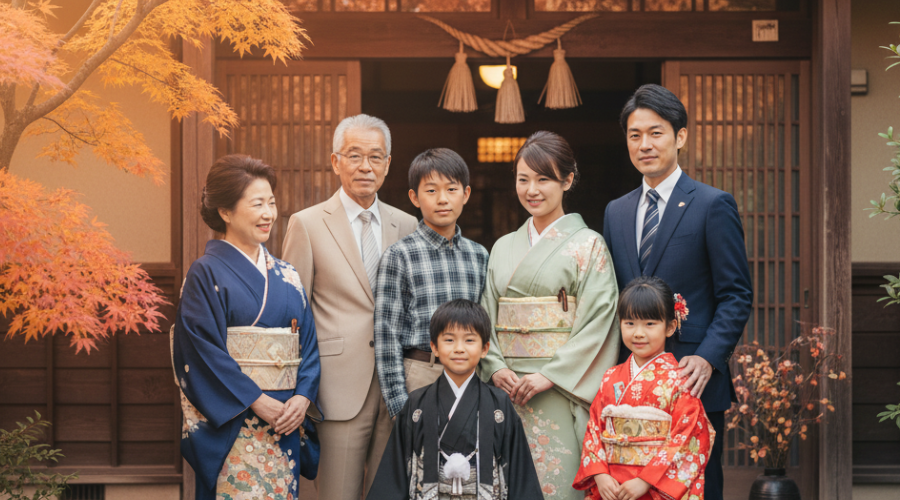
When inviting grandparents to a Shichi-Go-San celebration, it’s essential to discuss attire in advance.
To ensure no family member feels uncomfortable on the day, the top priority should be coordinating the level of formality between both families.
Golden Rule: The Three “Harmonies” Grandparents’ Outfits Should Follow
- Harmony with the Children: Since the children are the stars of the day, grandparents should choose attire that is slightly less formal so the children remain the most radiant.
- Harmony with the Parents: Match both the formality and style (kimono or Western wear) of the parents’ outfits.
- Harmony Between Families: Coordinate the level of formality between the paternal and maternal grandparents. If one side dresses casually while the other dresses formally, it may create an uncomfortable imbalance.
Western Attire for Grandparents: Recommended Styles and What to Avoid
Formally speaking, the dress code is either formal or semi-formal. However, as long as the level of formality matches that of the parents’ outfits, it is perfectly appropriate.
| Relation | Recommended Styles | Absolutely NG Outfits to Avoid |
|---|---|---|
| Grandfather | Dark-colored suit (same as the father). Your own suit is fine—no need to purchase a new one. A jacket paired with slacks is also appropriate for semi-formal outings. | Everyday casual wear such as T-shirts, chinos, jeans, sneakers, wrinkled slacks, or worn-out shirts. |
| Grandmother | Dresses or coordinated ensembles suitable for semi-formal outings. A jacket with skirt (or pants) set-up is also ideal. | Clothes more eye-catching than the children’s outfits, overly bold patterns or colors, and fabrics that are too casual (e.g., T-shirts, denim). |
| Accessories/Shoes | Pumps or leather shoes are the standard. Low heels or any shoes you are comfortable walking in are also acceptable. | Shoes that are too casual, such as sneakers or sandals. |
Grandparents in Kimono: Choosing with the Right Level of Formality
It can be elegant when all family members attending the Shichi-Go-San visit wear kimono.
Even in such cases, it is proper etiquette for grandparents to choose attire that is one step less formal than the children, who are the stars of the day.
For example, if the child wears haori and hakama (formal kimono with pleated trousers), the grandparents should opt for slightly less formal kimono such as homongi (visiting kimono) or iromuji (plain-colored kimono).
| Relation | Appropriate Kimono (Semi-Formal) | NG Examples: Too Formal for the Occasion |
|---|---|---|
| Grandmother | Homongi (visiting kimono), Iromuji (plain-colored kimono), or Tsukesage—all considered semi-formal kimono suitable for outings. | Kurotomesode (formal black kimono with family crests, the highest level of formality), which would be more formal than the grandchildren’s attire. |
| Grandfather | Kimono with haori (jacket) but without family crests. (If wearing Western clothing instead, a dark-colored suit is appropriate to match the formality level.) | — |
Three Outfit Coordination Examples for Grandparents
Since Shichi-Go-San is a precious day that will be remembered in photos, choosing attire that balances both elegance and festivity is essential.
Celebrate your grandchild’s growth with outfits that highlight the beauty of both kimono and Western attire.
Here, we’ll share tips for refined and graceful styles that are perfectly suited for this celebratory occasion.
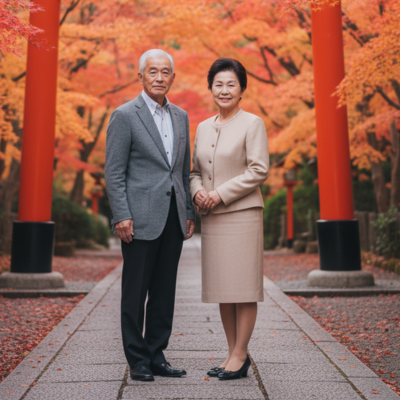
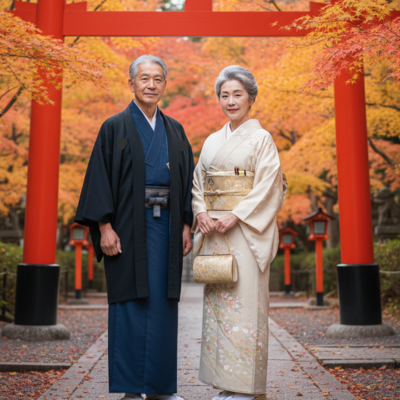
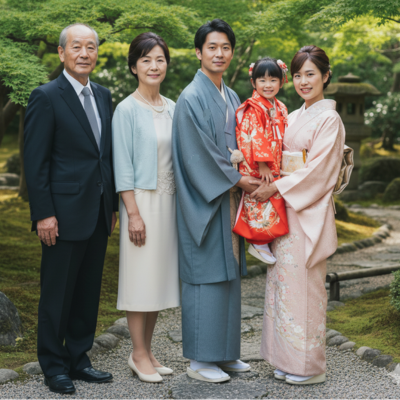
Shichi-Go-San Siblings’ Outfits: NG Examples and Recommended Styles by Age
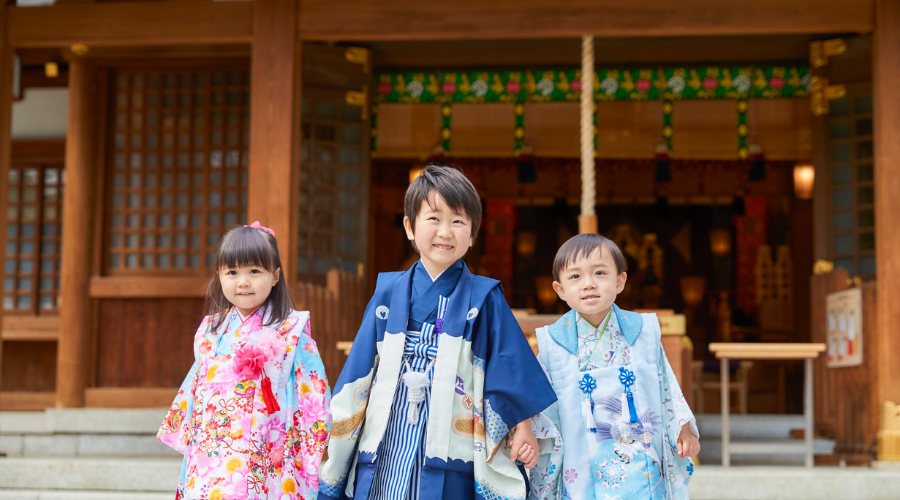
For siblings accompanying the Shichi-Go-San celebration, the basic rule is to wear “modest dress-up attire” that highlights the main child.
Think of formal outfits suitable for special occasions such as weddings or entrance ceremonies.
Siblings’ Outfits: Overall Etiquette and What to Avoid
| NG Example | Reason & Caution |
|---|---|
| Overly Casual Clothing | Everyday wear such as T-shirts, denim, or sneakers diminishes the sense of special celebration. |
| Outfits That Outshine the Main Child | Avoid flashy dresses for girls or outfits with colors/patterns more vivid than the main child’s attire. |
| Shoes | While familiar sneakers are acceptable, since shoes also appear in full-length photos, it’s best to choose loafers or formal shoes that match the outfit. |
【Additional Tip】
Using Rental Outfits
When taking commemorative photos at a studio, rental outfits for accompanying siblings may be available. To ensure everything goes smoothly, check in advance with the studio whether the outfits are for photography only or also suitable for outings.
Siblings’ Western Attire: School Uniforms and Formal Styles
If the child attends a school with a uniform, wearing it is the simplest and most formal choice.
For schools without uniforms, here are the recommended styles for boys and girls.
| Relation | Recommended Formal Style | Colors |
|---|---|---|
| Boys | A suit, or shirt with tie and trousers. In warmer seasons, a vest or short trousers paired with a jacket is also appropriate. | Chic colors such as black, navy, or gray. |
| Girls | A dress with a jacket, or a blouse paired with a skirt. | Subdued tones such as pastel colors, white, or other chic shades. |
Siblings in Kimono: Age-Based Dressing Etiquette
When siblings wear kimono together, it creates a sense of unity and adds a festive touch.
However, kimono has traditional dressing customs that vary depending on age.
| Siblings | Age | Kimono Customs |
|---|---|---|
| Boys | 5 and older | A formal outfit is a kimono with haori (jacket) and hakama (pleated trousers), the same style as adults. |
| Up to 4 | Traditionally, boys do not wear hakama until after the Hakamagi no Gi (ceremony of putting on hakama). However, wearing hakama at age three is allowed if it coincides with Shichi-Go-San. The typical style is a kimono with haori, but without hakama. | |
| Girls | 7 and older | The standard style is a kimono worn with an obi (belt/sash). |
| Up to 6 | The usual style is a kimono with a hifu (padded sleeveless jacket). To ensure the main child remains the focus, it is best to choose subdued colors. |
Three Outfit Coordination Examples for Siblings
Because Shichi-Go-San is such a memorable day captured in photos, it’s worth putting thought into the outfits of siblings as well.
By choosing attire that highlights the main child while still being elegant and appropriate for a celebratory occasion, you’ll make the family’s memories even more special.
For kimono, subdued colors are recommended; for Western attire, simple and refined options such as a neat dress or a vest style work beautifully.
Coordinating outfits that suit each sibling’s age helps everyone share in the festive atmosphere.
Here, we’ll share styling ideas that let siblings feel comfortable, confident, and ready to smile in the photos.
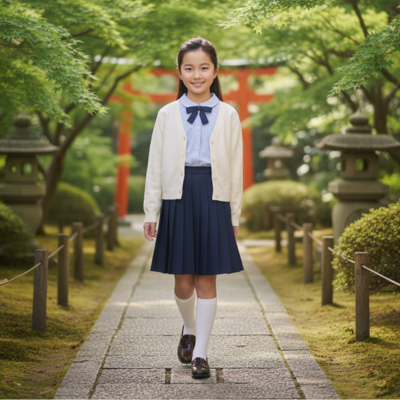
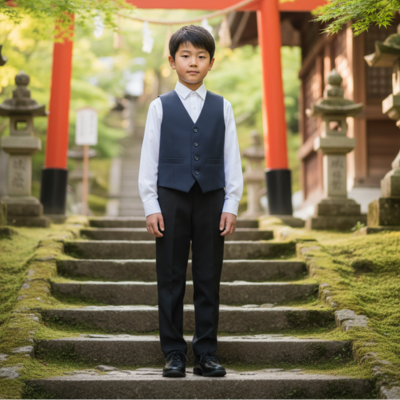
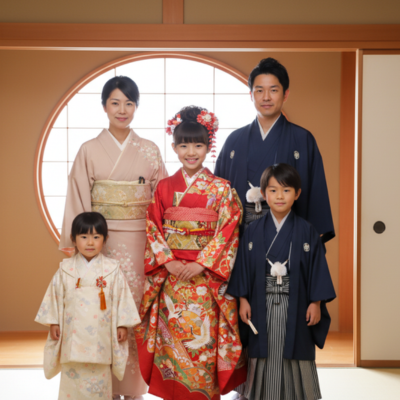
Q&A for Grandparents and Siblings: Money, Roles, and Other Etiquette
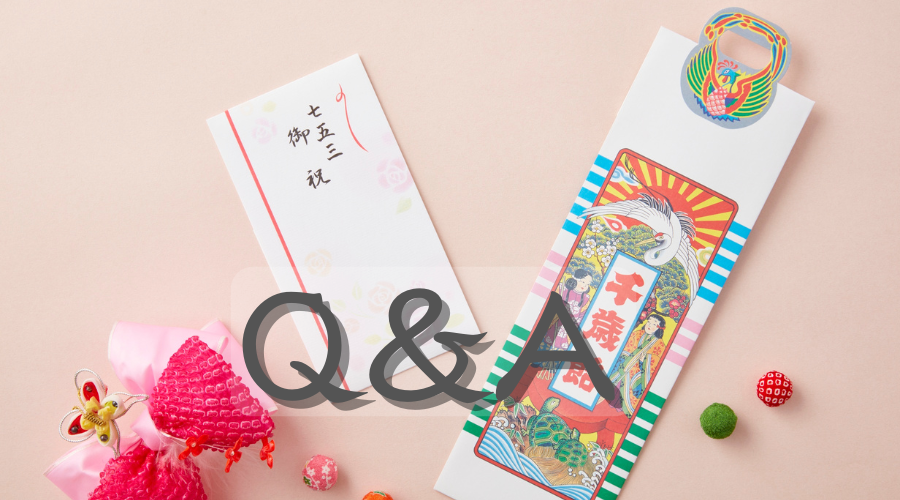
When it comes to preparing for Shichi-Go-San and how the day unfolds, questions often arise not only about attire but also regarding money and roles.
In this section, we’ll explain common etiquette and customs in a Q&A format.
**Q. What is the typical amount for a Shichi-Go-San celebratory gift (monetary offering), and what is the proper way to give it?**
| Item | Answer & Considerations |
|---|---|
| Typical Amount | The standard range is 10,000–30,000 yen. |
| Guideline for Amount | Around 10,000 yen: When only giving a monetary gift and the parents cover all expenses. Around 30,000–50,000 yen: When grandparents cover part or all of the costs for outfits, photography, or meals. |
| Points to Consider | Adjust the amount depending on whether you are also giving gifts such as kimono, or if additional expenses such as travel and accommodation are involved. |
| How to Give (Manners) | Present the money in a decorative ceremonial envelope (noshibukuro). |
| Wording on the Envelope | Write “Celebratory Gift” or “Shichi-Go-San Gift.” |
| Timing of Giving | On the day of the shrine visit or during the family celebratory meal. It is courteous to prepare crisp, new bills. |
**Q2. Who usually pays for the Shichi-Go-San photo session and celebratory meal?**
A. In general, the parents of the child are the ones who cover the costs.
- No strict rule: There are no fixed rules or formal etiquette regarding who should pay for the photography or meal expenses.
- Grandparents paying: Depending on family customs, regional traditions, or simply out of the grandparents’ wish to celebrate their grandchild’s growth, the grandparents may cover these expenses. In some cases, they may also give a monetary gift that exceeds the actual cost.
Most Important Point
To avoid misunderstandings or conflicts later on, it is essential for the parents and grandparents to discuss and agree in advance on how the expenses will be shared.
**Q3. Should grandparents attend Shichi-Go-San? What are the guidelines for deciding and considerations for both families?**
A. There is no strict rule that grandparents must attend Shichi-Go-San.
It is generally decided based on an invitation from the parents and according to the family’s circumstances.
1.Guidelines for Deciding Attendance: Confirm There Are No Difficulties
| Cases to Attend | Cases to Decline or Refrain |
|---|---|
| Both families live nearby, so access is not an issue. | Living far away, where long-distance travel would be too physically demanding. |
| There is a clear invitation from the parents. | Poor health or unavoidable personal circumstances. |
| The schedule and timing are manageable. | The financial burden of travel and accommodation is too great. |
2. Considerations for Both Families: Be Careful with “Only One Side” Attending
Since Shichi-Go-San is often celebrated just within the immediate family, inviting grandparents from both sides should be limited to situations where the schedule and access allow.
- Avoid favoritism between families: If one set of grandparents (paternal or maternal) is invited, ideally the other set should also be invited. Alternatively, the parents should explain carefully in advance why only one side is invited. Simply saying, “We’re only inviting one side,” can cause unnecessary tension between families.
- Be mindful of long distances: When both sets of grandparents gather, the parents may become exhausted by hosting. If one side has health issues or concerns about long-distance travel, it’s better not to force attendance and instead respect the parents’ decision.
Grandparents’ Mindset
Since there is no rule that says grandparents must be invited, it is important to prioritize the parents’ wishes. Striking a balance between the desire to attend and the consideration of not placing extra burdens on the parents is key.
**Q4. What exactly do grandparents do on the day of Shichi-Go-San?**
A. Grandparents are not only participants helping the day proceed smoothly but also play an important supporting role.
The priority should be to cooperate with the parents and help reduce the burden on the children.
1. Main Roles on the Day (Participation & Support)
- Attending the shrine or temple visit and prayer: This is an important ritual to pray for the healthy growth of the child. Grandparents may join the parents in receiving blessings, offering coins, and paying respects.
- Joining commemorative photo sessions: Being part of family group photos makes for a wonderful family memory. Grandparents may also help during the shoot—supporting or watching over the children so they don’t get too tired.
- Participating in the celebratory meal: It is common for the family, together with grandparents, to hold a meal after the visit. Whether at a restaurant or at home, grandparents take part and help create a festive atmosphere.
2.Preparations and Considerations in Advance (Points of Care)
| Item | What Grandparents Should Consider |
|---|---|
| Scheduling and Consultation | Coordinate in advance on the location for the shrine visit or meal, the schedule, and whether a photo session is included. It is important to consult with the parents ahead of time and share information among both families. |
| Reducing the Child’s Burden | Trying to complete all Shichi-Go-San events in a single day can be exhausting for the child. Make sure the schedule is not too demanding—for example, by spacing out photo sessions before or after the day—and encourage breaks on the day itself. |
| Final Outfit Check | Double-check the chosen outfit (Western or kimono) that was discussed with the parents beforehand, ensuring it is tasteful and elegant for the celebration. |
Conclusion: Etiquette Is Consideration — What Truly Matters Is the Family’s Smiles
For grandparents and siblings at Shichi-Go-San, the most important points are the etiquette of highlighting the child as the star of the day and maintaining harmony within the family.
As explained in this article, grandparents should match the level of formality with the parents’ attire, while siblings should choose modest outfits that do not outshine the children.
It is also key to confirm in advance as a family the traditional age-based customs for wearing kimono, as well as the etiquette and typical amounts for celebratory gifts, so the day can proceed smoothly.
Dress etiquette is, at its heart, an expression of thoughtfulness and consideration for one another.
By discussing and preparing together as a family, may this special day of Shichi-Go-San become a joyful and unforgettable memory filled with smiles for everyone.
Related Articles
Complete Guide to Shichi-Go-San for 3-Year-Olds
Complete Guide to Shichi-Go-San for 5-Year-Olds
Complete Guide to Shichi-Go-San for 7-Year-Olds
Shichi-Go-San Mothers’ Attire [Complete Guide]
Shichi-Go-San Fathers’ Attire [Complete Guide]
What Is Shichi-Go-San? A Clear Explanation of Its Meaning, Origins, and History
✿ Column: Fumi’s Kimono Diary ✿
Last year, I accompanied my niece to her Shichi-Go-San celebration.
She was a little nervous in her unfamiliar kimono, but the moment her grandmother gently held her hand, her expression immediately softened.
The child may be the star of the day, but it is the presence of grandparents and siblings—supporting from nearby—that allows the child to feel safe and smile with ease.
Looking back at the photos, I am reminded that more than the splendid attire, it is the warm, watchful gaze of loved ones that becomes the most treasured memory.
